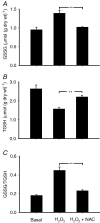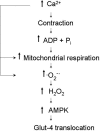Role of reactive oxygen species in contraction-mediated glucose transport in mouse skeletal muscle
- PMID: 16777943
- PMCID: PMC1819411
- DOI: 10.1113/jphysiol.2006.110601
Role of reactive oxygen species in contraction-mediated glucose transport in mouse skeletal muscle
Abstract
Exercise increases glucose transport into skeletal muscle via a pathway that is poorly understood. We investigated the role of endogenously produced reactive oxygen species (ROS) in contraction-mediated glucose transport. Repeated contractions increased 2-deoxyglucose (2-DG) uptake roughly threefold in isolated, mouse extensor digitorum longus (fast-twitch) muscle. N-Acetylcysteine (NAC), a non-specific antioxidant, inhibited contraction-mediated 2-DG uptake by approximately 50% (P < 0.05 versus control values), but did not significantly affect basal 2-DG uptake or the uptake induced by insulin, hypoxia or 5-aminoimidazole-4-carboxamide-1-beta-D-ribofuranoside (AICAR, which mimics AMP-mediated activation of AMP-activated protein kinase, AMPK). Ebselen, a glutathione peroxidase mimetic, also inhibited contraction-mediated 2-DG uptake (by almost 60%, P < 0.001 versus control values). Muscles from mice overexpressing Mn2+-dependent superoxide dismutase, which catalyses H2O2 production from superoxide anions, exhibited a approximately 25% higher rate of contraction-mediated 2-DG uptake versus muscles from wild-type control mice (P < 0.05). Exogenous H2O2 induced oxidative stress, as judged by an increase in the [GSSG]/[GSH + GSSG] (reduced glutathione + oxidized glutathione) ratio to 2.5 times control values, and this increase was substantially blocked by NAC. Similarly, NAC significantly attenuated contraction-mediated oxidative stress as judged by measurements of glutathione status and the intracellular ROS level with the fluorescent indicator 5-(and-6)-chloromethyl-2',7'-dichlorodihydrofluorescein (P < 0.05). Finally, contraction increased AMPK activity and phosphorylation approximately 10-fold, and NAC blocked approximately 50% of these changes. These data indicate that endogenously produced ROS, possibly H2O2 or its derivatives, play an important role in contraction-mediated activation of glucose transport in fast-twitch muscle.
Figures








Comment in
-
Many pathways are called! Many may be chosen!J Physiol. 2006 Aug 15;575(Pt 1):3. doi: 10.1113/jphysiol.2006.115592. Epub 2006 Jun 29. J Physiol. 2006. PMID: 16809355 Free PMC article. No abstract available.
References
-
- Balon TW, Nadler JL. Evidence that nitric oxide increases glucose transport in skeletal muscle. J Appl Physiol. 1997;82:359–363. - PubMed
-
- Belluardo N, Westerblad H, Mudo G, Casabona A, Bruton J, Caniglia G, Pastoris O, Grassi F, Ibanez CF. Neuromuscular junction disassembly and muscle fatigue in mice lacking neurotrophin-4. Mol Cell Neurosci. 2001;18:56–67. - PubMed
-
- Bonnefont-Rousselot D. Glucose and reactive oxygen species. Curr Opin Clin Nutr Metab Care. 2002;5:561–568. - PubMed
-
- Cartee GD, Douen AG, Ramlal T, Klip A, Holloszy JO. Stimulation of glucose transport in skeletal muscle by hypoxia. J Appl Physiol. 1991;70:1593–1600. - PubMed
-
- Cartee GD, Holloszy JO. Exercise increases susceptibility of muscle glucose transport to activation by various stimuli. Am J Physiol. 1990;258:E390–E393. - PubMed
Publication types
MeSH terms
Substances
Grants and funding
LinkOut - more resources
Full Text Sources
Other Literature Sources
Molecular Biology Databases

